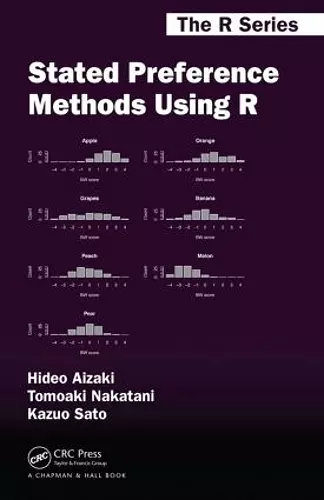Stated Preference Methods Using R
Kazuo Sato author Hideo Aizaki author Tomoaki Nakatani author
Format:Hardback
Publisher:Taylor & Francis Inc
Published:15th Aug '14
Currently unavailable, and unfortunately no date known when it will be back
This hardback is available in another edition too:
- Paperback£43.99(9781032924472)

Stated Preference Methods Using R explains how to use stated preference (SP) methods, which are a family of survey methods, to measure people’s preferences based on decision making in hypothetical choice situations. Along with giving introductory explanations of the methods, the book collates information on existing R functions and packages as well as those prepared by the authors. It focuses on core SP methods, including contingent valuation (CV), discrete choice experiments (DCEs), and best–worst scaling (BWS).
Several example data sets illustrate empirical applications of each method with R. Examples of CV draw on data from well-known environmental valuation studies, such as the Exxon Valdez oil spill in Alaska. To explain DCEs, the authors use synthetic data sets related to food marketing and environmental valuation. The examples illustrating BWS address valuing agro-environmental and food issues. All the example data sets and code are available on the authors’ website, CRAN, and R-Forge, allowing readers to easily reproduce working examples.
Although the examples focus on agricultural and environmental economics, they provide beginners with a good foundation to apply SP methods in other fields. Statisticians, empirical researchers, and advanced students can use the book to conduct applied research of SP methods in economics and market research. The book is also suitable as a primary text or supplemental reading in an introductory-level, hands-on course.
"This is a very useful introduction to the econometrics of stated preference methods. A very significant strength of the book is the use of R. I have been teaching this type of course for many years without the benefit of this book. I wish I had it many years ago."
—Bengt Kriström, Professor and Chair, Department of Forest Economics, Swedish University of Agricultural Sciences (SLU), and Research Director, Centre for Environmental and Resource Economics (CERE)
"It is wonderful to finally see a book on how to use R to estimate the welfare measures commonly used in nonmarket valuation studies. The authors provide a set of R functions for some of the procedures most commonly used with stated preference data. Just as important, like almost all R functions, the user can see how these functions were coded as a way of understanding how they work and how new functions can be created. Using R opens up a very wide range of statistical procedures and visualization tools that will allow researchers to look at their stated preference data in new ways."
—Richard T. Carson, Professor, Department of Economics, University of California, San Diego
"There are a number of very expensive statistical packages that can be used to analyze stated preference data. R is free so it is wonderful for teaching undergraduate students and others who don’t have access to expensive packages. Aizaki, Nakatani, and Sato have provided a valuable reference book for stated preference researchers and teachers who want to use R. I used the book to install R and the contingent valuation package in a few minutes. I was estimating CVM models soon afterwards. I’m especially excited that the package contains an easy-to-use nonparametric willingness to pay estimator that is superior to the spreadsheet methods I’ve been using for years. The package includes very well-known (Exxon Valdez) and less well-known (Albemarle-Pamlico) contingent valuation data. These data allow the user to play around with the package and compare results to what has been published in the literature. This book is an ideal reference for advanced undergraduate and graduate courses in environmental valuation."
—John C. Whitehead, Professor, Department of Economics, Appalachian State University
ISBN: 9781439890479
Dimensions: unknown
Weight: 498g
265 pages